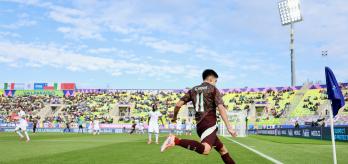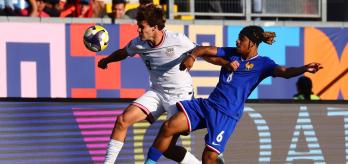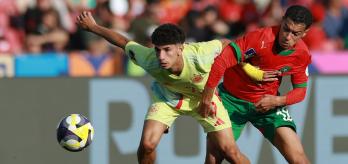Their ability to dominate both penalty areas has been a defining factor in their progression through this tournament, scoring 15 goals and conceding just two in their six consecutive victories to date.
FIFA Technical Study Group expert Marcin Dorna explains how the character of the team has been a standout feature in their tournament performances to date.
“One of this team’s greatest strengths is how every player contributes in both phases of the game — attack and defence. There is a strong, collective work ethic and a willingness to support team-mates in all situations, highlighting the team’s tactical discipline and physical preparation.
“Mentally, the team appear fully prepared. They play with unity, focus and a shared purpose. The synergy within the squad is evident, not only in their coordinated movements on the pitch but also in the way they stay emotionally composed throughout the match.”
In possession
Argentina have demonstrated tactical flexibility, seamlessly changing formations/systems from match to match, as well as mid-game. In their semi-final victory over Colombia, they started with a 1-3-4-3 before changing to a 1-4-4-2 in the second half, and then switched to a 1-5-3-2 for the final stages of the game. Each formation change had a clear purpose and tactical reason, with players demonstrating a clear understanding of their roles and responsibilities.
The intensity and cohesion generated in their attacking play are also key factors in the success of this team, as Dorna explains.
“In the attacking penalty area, players showcased excellent technique in their combination play in tight spaces, often creating goalscoring opportunities even when time and space were limited. Under pressure, they remained composed and intelligent in their decision-making.”
The team’s ability to combine passes in tight spaces is also a key success factor in how they build their play and progress the ball. Argentina often lure opposition players into condensed areas of the pitch before switching the ball out to areas where they have space for fast attacks.
Out of possession
Defensively, Argentina control the game through compactness, organisation and their ability as a team to work as a unit. This makes it extremely difficult for opposition teams to play through them. When they press, they do it with intensity and cohesion, particularly when defending in their own defensive third.
Having conceded just two goals in their six matches to date, they have also limited their opponents to low-value goalscoring chances.
As Dorna explains, “Argentina show remarkable commitment, resilience and togetherness when they do not have the ball. They work as a team in all defensive phases, and I have been impressed with how they defend inside their own penalty area. They make sacrificial and spectacular defensive interventions — blocking shots, covering for one another and showing a collective will to protect their goal. The defensive line, midfielders and even forwards contributed to maintaining a compact, synchronised shape.”
GOALKEEPER: Santino Barbi
An ever-present figure in their team throughout this tournament, goalkeeper Santino Barbi has proved himself to be a key component in Argentina’s defensive successes, with commanding performances leading to four clean sheets in six games.
As goalkeeping expert Pascal Zuberbühler explains, “Due to how well his outfield players defend, he does not always have a high number of interventions to make in a game. However, this means his concentration levels must be very high, and he has shown how alert and ready he is, especially in big moments of the game. He is brave, good under high balls and defends on the front foot.”
In the radar graphic below, we can see how Barbi’s lower volume of interventions (highlighted in the internal shaded areas) in some goalkeeping metrics has influenced his overall ranking (detailed on the outside of the graphic). However, this does not affect the quality of his interventions when they have been needed.
Interestingly, he has faced eight through balls, which is three more than any other goalkeeper in the tournament to date. Of these through-ball situations faced, six occurred inside the penalty area, with Barbi making successful interventions for five of those six.
For Zuberbühler, the prevalence of the through-ball scenarios faced by Barbi demonstrates that opposition teams are targeting these as a way of breaching Argentina’s defensive line.
“When dealing with through balls, the starting position and timing of the interventions are vital, as the goalkeeper must decide when to defend the goal and when to defend the ball. When his team are defending in a mid-block, Barbi takes control of the space in behind and it is clear his team-mates trust him fully. As we see in the clip below, his decision-making and timing are excellent. He knows the ball will come and has a clear understanding of when his defenders can deal with it, and when he must come and deal with it.”















